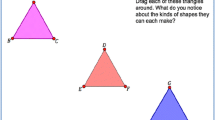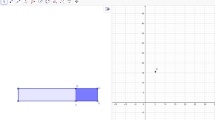Abstract
Straightedge-and-compass construction problems in Euclidean geometry are known, at times, to be unsolvable. In such cases, additional mathematical tools, such as the Archimedean spiral, may yield a solution. Dynamic geometry (DG) environments suggest adding another mathematical tool as an alternative to the classical approach to geometric constructions: Continuous variation of one of the parameters of the problem. Adoption of this approach raises both mathematical and didactic issues for discussion. This paper presents several solved problems of triangle construction given data that includes angle bisectors. Some of these problems have been shown to be otherwise unsolvable; others may be solvable, but, to the author’s best knowledge, have not been solved using only classical tools. Presented for solution to a special group of prospective teachers, these problems provided them with the experience of facing the need to justify a DG-based solution mathematically, distinguish a ‘dynamic illustration’ from a self-consistent algorithm and refer to mathematical constraints or ‘rules of the game’ – altogether a challenging and fruitful learning opportunity.












Similar content being viewed by others
Notes
For an illustration, see, for example: https://www.youtube.com/watch?v=U-v0CBhgq4k.
References
Barabash, M. (2005). A non-visual counterexample in elementary geometry. The College Mathematics Journal, 36(5), 397–400.
Barabash, M., Gurevich, I., & Yanovsky, L. (2009). Usage of computerised environment in the undergraduate course ‘Plane transformations and constructions in geometry. International Journal for Technology in Mathematics Education, 16(2), 49–62.
Courant, R., & Robbins, H. (1978). What is mathematics? An elementary approach to ideas and methods. Oxford: Oxford University Press.
Davis, P. (1995). The rise, fall, and possible transfiguration of triangle geometry: a mini-history. The American Mathematical Monthly, 102(3), 204–214.
Delone, B., & Zhitomirsky, O. (1959). Zadachnik po geometrii (A problem book in geometry). Moscow, Russia: Physmatgis (in Russian).
Epstein, D., & Levy, S. (1995). Experimentation and proof in mathematics. Notices of the American Mathematical Society, 42(6), 670–974.
Katz, V. (1998). A history of mathematics: An introduction (2nd ed.). Reading: Addison-Wesley.
Leung, A., Baccaglini-Frank, A., & Mariotti, M. (2013). Discernment of invariants in dynamic geometry environments. Educational Studies in Mathematics, 84(3), 439–460.
Zajic, V. (2003). Triangle from angle bisectors. http://www.cut-the-knot.org/triangle/TriangleFromBisectors.shtml. Accessed 29/1/19
Author information
Authors and Affiliations
Corresponding author
Additional information
Publisher’s Note
Springer Nature remains neutral with regard to jurisdictional claims in published maps and institutional affiliations.
Appendices
Appendix 1
Sample Triangle Construction Problem: A Paper-and-Pencil Solution
Construct a triangle by one of its sides (a) and median (ma) and height (ha) related to this side.
Solution (see Fig. 13):
-
1.
For the analysis, draw an arbitrary triangle and its height and median to one of its sides. The right triangle formed by these elements is constructible by compass and straightedge, in which Height ha is one of its legs and Median ma is the hypotenuse. From here, the requested triangle is obtained by allocating half of the given Side a on the line containing the second leg at each side of the vertex of the acute angle.
-
2.
Construct the right triangle and complete it to the requested one.
-
3.
Prove that the construction meets the conditions of the problem. In this case, the proof follows from the construction procedure (which is not necessarily the case for every construction problem).
-
4.
Investigation:
If ma < ha, no right triangle exists; in this case, there is no solution to the problem.
If ma = ha, the right triangle degenerates into one segment; in this case, there is a solution: an isosceles triangle.
If ma > ha, a solution exists.
Wherever a solution exists, it is unique; this follows from the construction procedure.
This problem is also solvable by the continuity procedure, obviously resulting in a triangle congruent to the one constructed by purely Euclidean tools. For both cases, the three given segments may be changed continuously, leading to corresponding changes in the resulting triangle. The difference is as follows: Continuous variation in one of the given segments causes the triangle produced by the Euclidean procedure to change automatically, preserving the other given segments and their place and role (median, height or side), whereas changing one of the given segments (for example, the height ha) for a triangle constructed by continuity triggers a corresponding variation in the degree of freedom that defines the solution, consequently re-adjusting it, so that the triangle again solves the problem. Irrespective of this difference, in both cases the solution continuously depends on the given data, and exists and is unique for any combination of values compatible with the geometric constraints.
To demonstrate the importance of each step of the solution, one may try to solve another problem, namely, constructing a triangle by ∠C, mb, a, to see that it may have 0, 1 or 2 (non-congruent) solutions, depending on the relations among the elements.
Appendix 2
An ‘Example’ in which Median and Angle Bisector of a Triangle seem to Coincide, while the Height from the Same Vertex is External to the Triangle
This drawing was intentionally constructed in order to warn the students from relying upon a geometric drawing, even one pretty neat and computer-generated, without analyzing its plausibility. The segments BD and DC are not equal, but it is not easy to discern the difference in their lengths unless one is aware of impossibility of such a situation.
Rights and permissions
About this article
Cite this article
Barabash, M. Dragging as a Geometric Construction Tool: Continuity Considerations Inspired by Students’ Attempts. Digit Exp Math Educ 5, 124–144 (2019). https://doi.org/10.1007/s40751-019-0050-2
Published:
Issue Date:
DOI: https://doi.org/10.1007/s40751-019-0050-2






